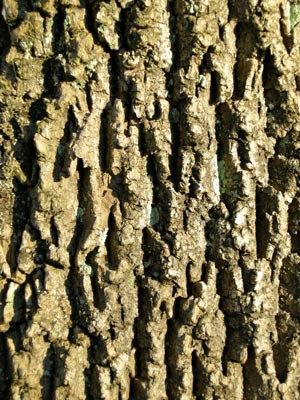Tree bark can act as a record of all sorts of events: lightning, fire, mechanical scrapes, and even the brief spark of youthful passion, carved with pocketknife, complete with heart, arrow, and initials.
Like our own human skin, bark bears the brunt of a wound, scarring over to protect the vital machinery inside. And as our skin respires and absorbs chemicals from our environment, so, too, does a tree’s bark absorb components of the air it is bathed in, recording – more subtly than a scar – invisible aspects of the atmospheric environment.
Scientists Xinghua Qui and Ronald Hites, from Indiana University’s School of Public and Environmental Affairs, took advantage of this absorptive capacity of tree bark in a study that sought to determine the source of an environmental pollutant. They recently reported in the journal Environmental Science and Technology that the bark of trees in the Northeast contains traces of the chemical Dechlorane Plus (DP), one of the many different types of flame retardants used in household products – from mattresses to carpets and curtains – to minimize fires. Their research showed that the closer the trees are to where DP is manufactured, the higher its concentration in their bark.
Hites and Qui were interested in determining the chief source of DP into the environment of the Great Lakes, where it is showing up in all sorts of places including the air, sediment, fish, and herring gull eggs. Dechlorane Plus was introduced as a substitute for Dechlorane – also known as Mirex – a highly chlorinated flame retardant whose use was curtailed in the 1970s because of its negative environmental effects. It turns out DP may not be as safe a replacement as was initially hoped.
To understand the effects of DP on ecosystems, it is important to know, first off, where it originates. A manufacturing facility in Niagara Falls, New York, was chief on the researchers’ list of potential sources. With an epicenter to focus their efforts on, they designed a sampling regime that involved taking bits of bark of selected trees, some of which were quite close to the Niagara manufacturing facility (a few miles), others of which were much farther away (Indiana, Virginia, and Maryland).
The scientists chose pines, which have coarse bark that is high in lipids (which absorb pollutants), and collected three tiny (50 to 100 g) samples from each test tree. Samples were then shipped to a lab and tested not only for DP but also for several other so-called brominated flame retardants, or BFRs.
Their results showed the highest concentrations of DP in bark from trees nearest Niagara Falls and Buffalo, New York, confirming the scientists’ hypothesis that the Niagara Falls manufacturing facility was the chief source of the DP. The most-concentrated sample came from the bark of a pine located only two kilometers away from the facility. Concentrations fell as distances from the facility grew.
Conversely, concentrations of the other BFRs, which are manufactured in Arkansas, were much lower than those found in the bark of trees near those chemicals’ manufacturers.
This study, and similar ones (including one that showed that PCBs are more concentrated in the bark of trees near several Superfund sources), confirms that tree bark is a reliable and inexpensive way to measure and track atmospheric pollutants.
As a result of this work, DP has been added to a list of chemicals that are now sampled on a regular basis by the Integrated Atmospheric Deposition Network. Having a complete picture – from source to sink – is the first step in understanding how pollutants such as DP move through our environment and ultimately affect organisms, including us.


